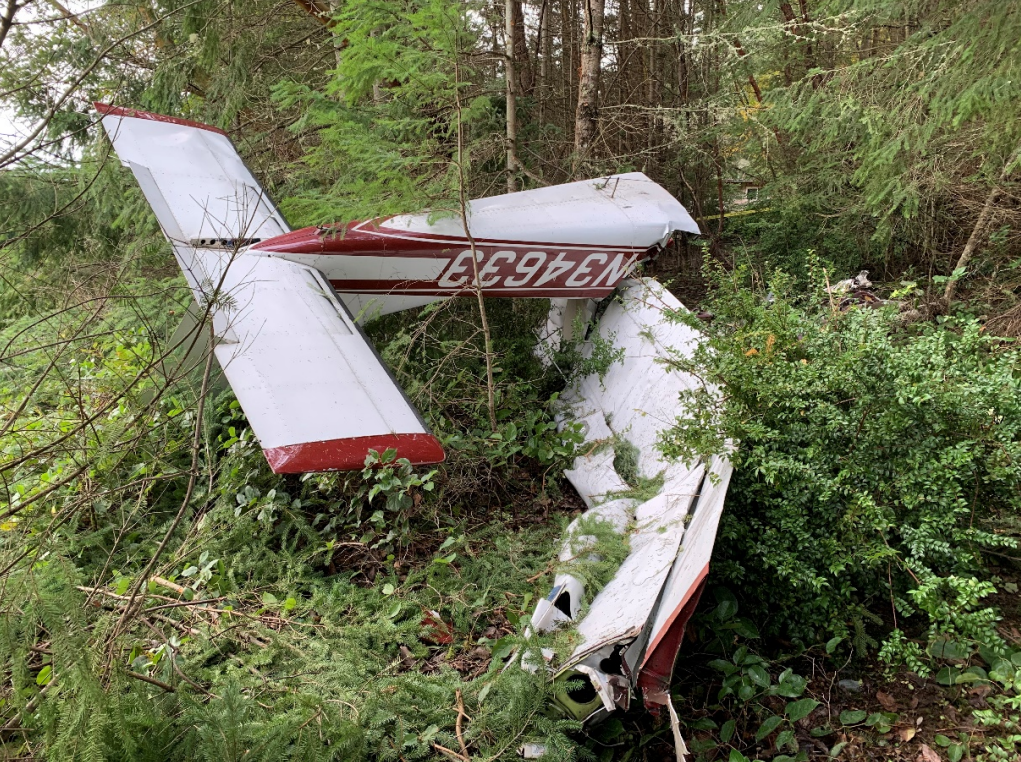
ASN Wikibase Occurrence # 244815
This information is added by users of ASN. Neither ASN nor the Flight Safety Foundation are responsible for the completeness or correctness of this information.
If you feel this information is incomplete or incorrect, you can submit corrected information.
| Date: | Wednesday 11 November 2020 |
| Time: | 11:44 |
| Type: |  Cessna 177B Cardinal |
| Owner/operator: | Lazy Eight Flying Club Inc |
| Registration: | N34633 |
| MSN: | 17701913 |
| Year of manufacture: | 1973 |
| Total airframe hrs: | 6313 hours |
| Engine model: | Lycoming O-360-A1F6D |
| Fatalities: | Fatalities: 2 / Occupants: 2 |
| Aircraft damage: | Destroyed |
| Category: | Accident |
| Location: | Whidbey Airpark (W10), Whidbey Island, WA -
 United States of America United States of America
|
| Phase: | Approach |
| Nature: | Private |
| Departure airport: | Bellingham Airport, WA (BLI/KBLI) |
| Whidbey Airpark, WA (W10) | |
| Investigating agency: | NTSB |
| Confidence Rating: |
On November 11, 2020, at 1144 Pacific standard time, a Cessna 177B airplane, N34633, was substantially damaged when it was involved in an accident near Whidbey Air Park (W10), Langley, Washington. The private pilot and flight instructor were fatally injured. The airplane was operated as a Title 14 Code of Federal Regulations Part 91 personal flight.
About 16 minutes after takeoff, at 6,500 ft above mean sea level , the airplane’s groundspeed decreased and the airplane started to descend. Shortly thereafter, the flight instructor reported to air traffic control that they were declaring an emergency because they were at full power and rpm setting, and about to lose the engine. They were also unable to maintain altitude. The airplane continued southeast for about 2 miles when it made a left turn east and then back to the southeast. The flight instructor reported they had a little power but were still descending. He further stated that the engine would not stay on for very long and they were at idle power. The controller asked if he had carburetor heat on and he replied “affirmative.”
Shortly thereafter, the flight instructor reported that they did not have engine power and they were going directly to nearby Whidbey Air Park, Langley, Washington. The airplane crossed and flew over a highway before turning north to the airport. Shortly thereafter, the flight instructor stated they were diverting off-airport and the airplane track turned right away from the airport. However, about 15 seconds later he reported the airport insight and the airplane’s track changed back toward the airport. There was no further communication from the accident airplane. The last radar point was over the runway at an altitude of about 300 ft.
A witness reported who was at the airport observed the accident airplane about pattern altitude passing from west to east. The accident airplane continued slightly east of the airport before it made a left turn to a northwest heading. It appeared as if the airplane was “porpoising,” continuously nosing up and down. He noted that the propeller was not turning and there were no audible engine sounds. As the airplane passed over the runway the left wing dropped, and the airplane spun out of sight behind the trees and hangars. Shortly thereafter, the witness heard the impact. The airplane came to rest about 153 ft west of the runway surface against trees that were about 65 ft tall. The witness account and the condition of the wreckage were indicative of the flight instructor’s failure to maintain airspeed, which resulted in an aerodynamic stall and subsequent spin.
A postaccident airframe and engine examination did not reveal any anomalies that would have precluded normal operations. The airplane’s engine monitoring system revealed the carburetor temperature had been steadily decreasing from 31°F during the accident flight. When the carburetor temperature reached 17°F there was an abrupt decrease in fuel flow and a corresponding reduction in exhaust gas temperatures. For the remainder of the flight, the exhaust and cylinder head temperatures slowly decreased, and the carburetor temperature slowly increased. The fuel flow spiked several times but immediately decreased.
The nearest weather reporting station reported the temperature as 6°C and dewpoint, 2°C. When plotted on the carburetor ice chart, this temperature dewpoint spread is consistent with serious icing at cruise power. Therefore, it is likely carburetor ice was building during the accident flight and it eventually starved the engine of fuel.
Probable Cause: The flight instructor’s failure to maintain airspeed, which resulted in an aerodynamic stall and subsequent loss of control while attempting to conduct an emergency landing. Contributing to the accident was a total loss of engine power as a result of carburetor icing.
Accident investigation:
 |
|
Sources:
https://katu.com/news/local/small-plane-crash-on-whidbey-island-injuries-and-cause-unknown-at-this-time?fbclid=IwAR3OdWj8aLR2rVBR5l4NoCSpcm-dExt75tfiIVuyMuSfgHeXVF9yv4zbyWU
https://www.king5.com/article/news/local/plane-crash-on-whidbey-island/281-beadc670-0ed4-4eb9-9456-20bc0939ba85
FAA
NTSB
https://www.airport-data.com/images/aircraft/001/124/001124135.jpg (photo)
History of this aircraft
Other occurrences involving this aircraft
| 31 July 2002 | N34633 | Private | 0 | Elma, Washington |  |
sub |
Location
Images:


Photos: NTSB
Revision history:
| Date/time | Contributor | Updates |
|---|---|---|
| 12-Nov-2020 00:51 | Captain Adam | Added |
| 12-Nov-2020 14:31 | RobertMB | Updated [Time, Aircraft type, Registration, Cn, Operator, Location, Phase, Nature, Departure airport, Destination airport, Source, Narrative] |
| 12-Nov-2020 15:10 | Copi | Updated [Aircraft type, Registration, Cn, Operator, Source] |
| 12-Nov-2020 15:53 | RobertMB | Updated [Time, Aircraft type, Operator, Location, Phase, Nature, Departure airport, Destination airport, Source, Narrative] |
| 05-May-2021 19:18 | rvargast17 | Updated [Time, Source] |
| 10-Jul-2021 09:26 | aaronwk | Updated [Time, Source, Narrative, Category] |
| 13-Aug-2022 11:00 | Captain Adam | Updated [Source, Narrative, Accident report, Photo] |
| 13-Aug-2022 11:00 | Captain Adam | Updated [Photo] |
Corrections or additions? ... Edit this accident description
The Aviation Safety Network is an exclusive service provided by:


 ©2024 Flight Safety Foundation
©2024 Flight Safety Foundation